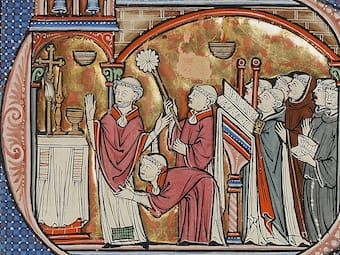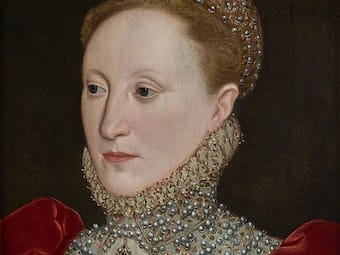319
William Pitt was a rising star of British politics in 1741, so much so that Horace Walpole MP felt he needed his wings clipped — an operation fraught with peril.
On March 10th, 1741, veteran MP Horace Walpole (1678-1757), the Prime Minister’s brother, fancied that he would silence that upstart William Pitt (1708-1778) by drawing attention to his inexperience, and scolding him for his theatrical manners of speech and gesture. He drew a reply of such withering sarcasm that it merely confirmed Pitt as the rising statesman of his generation.
Picture: From the studio of William Hoare (1707–1792), Wikimedia Commons. Licence: Public domain.. Source.
Posted January 1 2022
320
Imma claimed to be a harmless peasant, but there was something about him that Ecgfrith, King of Northumbria, found downright uncanny.
In 679, King Ecgfrith of Northumbria’s imperial ambitions were severely dented at the Battle of Trent, when he failed to defeat King Ethelred of Mercia somewhere near Lincoln, and lost control of the Kingdom of Lindsey. After telling us about this sorry business, Bede recalled hearing a story about one of Ethelred’s thegns (royal servants), told to him by friends who had it from the man himself.
Picture: Attributed to Michael Lupi de Çandiu (fl. 1297-1305), via the J. Paul Getty Museum in Los Angeles, and Wikimedia Commons. Licence: Public domain.. Source.
Posted December 29 2021
321
Queen Elizabeth I’s quick thinking and command of five European languages made her a dangerous enemy in a war of words.
In 1588, King Philip of Spain sent a vast Armada against England. As the husband of the late Queen Mary I, he thought the English crown should have gone to him and not to her half-sister Elizabeth, and now Elizabeth was supporting Protestant rebels in the Spanish Netherlands. Hoping to daunt this upstart Englishwoman, he threatened war in Latin verse, no less; but the Queen was not a novice in the art of verbal fencing.
Picture: By an anonymous artist of the English School (1560s), via Wikimedia Commons. Licence: Public domain.. Source.
Posted December 25 2021
322
Luka had netted a nice little haul of stolen coins and antiques, but he could not resist stripping down the historic Icon of the Sign too.
The ‘Virgin of the Sign’ is a twelfth-century icon of the Virgin Mary kept to this day in Great Novgorod, Russia — the ‘sign’ refers to the promise made by the prophet Isaiah to King Ahaz, that one day a virgin would conceive and bear a son. In 1170 the icon saved the city from a siege, and a special church was built for it, but it would seem that by the seventeenth century the mystique was beginning to wear off.
Picture: © Mortier.Daniel, Wikimedia Commons. CC BY-SA 4.0.. Source.
Posted December 22 2021
323
Many of Australia’s first cities were planned by British bureaucrats who had never been there, which may explain why they put them in the wrong places.
In 1835, John Batman (1801-1839) of Launceston in Tasmania set out across the Bass Strait in the schooner Rebecca to explore Port Philip, a large, sheltered bay on the southern coast of Australia. What he saw only confirmed what he had heard from others, and on June 8th he jotted down in his diary, next to a sketch of the place where the Yarra empties into the Bay: ‘reserved for a township and other purposes’.
Picture: © Melbpal, Wikimedia Commons. Licence: CC BY-SA 4.0.. Source.
Posted December 21 2021
324
William Murdoch and Samuel Clegg brought warmth and light into the country’s streets, factories and homes, but the public didn’t make it easy.
Before natural gas there was coal gas, which warmed living rooms and lit streets all over the United Kingdom until the 1960s. Coal gas does not occur naturally, and Archibald Cochrane (1748-1831), 9th Earl of Dundonald, discovered it only by chance, while making coal tar near Culross Abbey in the 1780s. It fell to another Scotsman to make coal gas commercially viable.
Picture: © Stephen McKay, Geograph. Licence: CC BY-SA 2.0.. Source.
Posted December 16 2021




